Abstract
Dopamine is present in the carotid body and has been postulated to be an inhibitory neurotransmitter. The purpose of this study was to determine the effects of dopamine on ventilation in man and to examine its mechanism of action. Dopamine (0.5-10 μg/kg per min) was infused in eight normal men at different levels of arterial chemoreceptor activity, produced by varying the inspired Po2. During normoxia dopamine produced a small decrease in minute ventilation (V̇e) and an increase in arterial Pco2. When arterial chemoreceptors were stimulated by hypoxia, infusion of dopamine produced a marked initial depression of V̇e followed by a sustained although less pronounced decrease in V̇e. An increase in Paco2 and a decrease in Pao2 were also observed. When arterial chemoreceptor activity was suppressed by hyperoxia, infusion of dopamine did not affect ventilation. Subjects also breathed a hypercarbic, hyperoxic gas mixture. The hypercarbia produces hyperventilation by stimulating central chemoreceptors, whereas the hyperoxia suppresses peripheral chemoreceptors. Dopamine did not alter ventilation while the subjects were breathing this gas mixture.
These studies suggest that dopamine suppresses ventilation in man through an action on the arterial chemoreceptor reflex. These findings support the hypothesis that dopamine is an inhibitory neurotransmitter in the carotid body, and that release of dopamine may modulate the sensitivity of peripheral arterial chemoreceptors.
Full text
PDF





Selected References
These references are in PubMed. This may not be the complete list of references from this article.
- Antelman S. M., Caggiula A. R. Norepinephrine-dopamine interactions and behavior. Science. 1977 Feb 18;195(4279):646–653. doi: 10.1126/science.841304. [DOI] [PubMed] [Google Scholar]
- Black A. M., Comroe J. H., Jr, Jacobs L. Species difference in carotid body response of cat and dog to dopamine and serotonin. Am J Physiol. 1972 Nov;223(5):1097–1102. doi: 10.1152/ajplegacy.1972.223.5.1097. [DOI] [PubMed] [Google Scholar]
- Bolme P., Fuxe K., Hökfelt T., Goldstein M. Studies on the role of dopamine in cardiovascular and respiratory control: central versus peripheral mechanisms. Adv Biochem Psychopharmacol. 1977;16:281–290. [PubMed] [Google Scholar]
- Chiocchio S. R., Biscardi A. M., Tramezzani J. H. Catecholamines in the carotid body of the cat. Nature. 1966 Nov 19;212(5064):834–835. doi: 10.1038/212834a0. [DOI] [PubMed] [Google Scholar]
- Chiocchio S. R., King M. P., Carballo L., Angelakos E. T. Monoamines in the carotid body cells of the cat. J Histochem Cytochem. 1971 Oct;19(10):621–626. doi: 10.1177/19.10.621. [DOI] [PubMed] [Google Scholar]
- DEJOURS P. Chemoreflexes in breathing. Physiol Rev. 1962 Jul;42:335–358. doi: 10.1152/physrev.1962.42.3.335. [DOI] [PubMed] [Google Scholar]
- Dearnaley D. P., Fillenz M., Woods R. I. The identification of dopamine in the rabbit's carotid body. Proc R Soc Lond B Biol Sci. 1968 Jun 11;170(1019):195–203. doi: 10.1098/rspb.1968.0033. [DOI] [PubMed] [Google Scholar]
- Goldberg L. I. Cardiovascular and renal actions of dopamine: potential clinical applications. Pharmacol Rev. 1972 Mar;24(1):1–29. [PubMed] [Google Scholar]
- HORWITZ D., FOX SM 3. D., GOLDBERG L. I. Effects of Dopamine in man. Circ Res. 1962 Feb;10:237–243. doi: 10.1161/01.res.10.2.237. [DOI] [PubMed] [Google Scholar]
- Heistad D. D., Wheeler R. C. Effect of acute hypoxia on vascular responsiveness in man. I. Responsiveness to lower body negative pressure and ice on the forehead. II. Responses to norepinephrine and angiotensin. 3. Effect of hypoxia and hypocapnia. J Clin Invest. 1970 Jun;49(6):1252–1265. doi: 10.1172/JCI106338. [DOI] [PMC free article] [PubMed] [Google Scholar]
- Heistad D. D., Wheeler R. C., Mark A. L., Schmid P. G., Abboud F. M. Effects of adrenergic stimulation on ventilation in man. J Clin Invest. 1972 Jun;51(6):1469–1475. doi: 10.1172/JCI106943. [DOI] [PMC free article] [PubMed] [Google Scholar]
- Hellström S., Hanbauer I., Costa E. Selective decrease of dopamine content in rat carotid body during exposure to hypoxic conditions. Brain Res. 1976 Dec 17;118(2):352–355. doi: 10.1016/0006-8993(76)90725-3. [DOI] [PubMed] [Google Scholar]
- Huckauf H., Ramdohr B., Schröder R. Dopamine induced hypoxemia in patients with left heart failure. Int J Clin Pharmacol Biopharm. 1976 Oct;14(3):217–224. [PubMed] [Google Scholar]
- Jacobs L., Comroe J. H., Jr Stimulation of the carotid chemoreceptors of the dog by dopamine. Proc Natl Acad Sci U S A. 1968 Apr;59(4):1187–1193. doi: 10.1073/pnas.59.4.1187. [DOI] [PMC free article] [PubMed] [Google Scholar]
- Leusen I. Regulation of cerebrospinal fluid composition with reference to breathing. Physiol Rev. 1972 Jan;52(1):1–56. doi: 10.1152/physrev.1972.52.1.1. [DOI] [PubMed] [Google Scholar]
- NIEMI M., OJALA K. CYTOCHEMICAL DEMONSTRATION OF CATECHOLAMINES IN THE HUMAN CAROTID BODY. Nature. 1964 Aug 1;203:539–540. doi: 10.1038/203539a0. [DOI] [PubMed] [Google Scholar]
- Oldendorf W. H. Brain uptake of radiolabeled amino acids, amines, and hexoses after arterial injection. Am J Physiol. 1971 Dec;221(6):1629–1639. doi: 10.1152/ajplegacy.1971.221.6.1629. [DOI] [PubMed] [Google Scholar]
- Osborne M. P., Butlar P. J. New theory for receptor mechanism of carotid body chemoreceptors. Nature. 1975 Apr 24;254(5502):701–703. doi: 10.1038/254701a0. [DOI] [PubMed] [Google Scholar]
- Sampson S. R. Mechanism of efferent inhibition of carotid body chemoreceptors in the cat. Brain Res. 1972 Oct 13;45(1):266–270. doi: 10.1016/0006-8993(72)90236-3. [DOI] [PubMed] [Google Scholar]
- Sampson S. R., Nicolaysen G., Jaffe R. A. Influence of centrifugal sinus nerve activity on carotid body catecholamines: microphotometric analysis of formaldehyde-induced fluorescence. Brain Res. 1975 Mar 7;85(3):437–446. doi: 10.1016/0006-8993(75)90818-5. [DOI] [PubMed] [Google Scholar]
- Steele R. H., Hinterberger H. Catecholamines and 5-hydroxytryptamine in the carotid body in vascular, respiratory, and other diseases. J Lab Clin Med. 1972 Jul;80(1):63–70. [PubMed] [Google Scholar]


